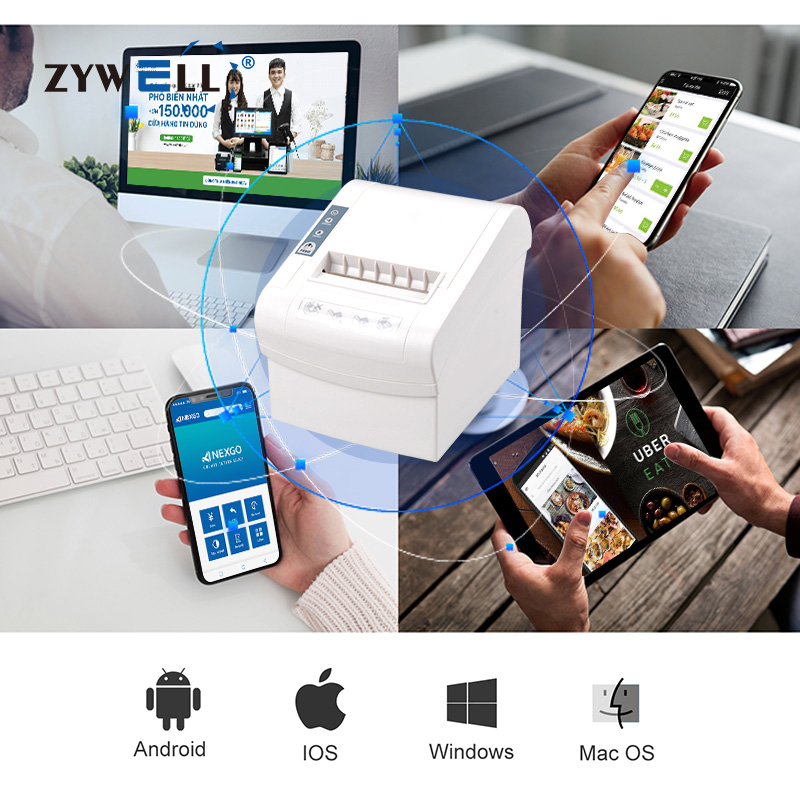ZYWELL thermal printer and pos printer manufacturer supplier in China for more than 20 years.
The Working Principle of Thermal Printers
Thermal printers represent a unique class of printing technology that operates differently from traditional inkjet or laser printers. They offer a contactless and ink-free printing method, which is not only cost-effective but also efficient and environmentally friendly. Here's an in-depth look at how thermal printers work:

Semiconductor Heating Elements:
The core of a thermal printer is its print head, which is equipped with semiconductor heating elements. These elements, when通电, generate heat almost instantaneously. This heat is crucial for the printing process as it triggers the color-changing reaction on the thermal paper.
Heat Activation:
Thermal paper, also known as thermosensitive paper, is coated with a special layer that reacts to heat. This layer contains a colorless dye (also called a leuco dye) and a developer. When the heating elements of the print head come into contact with the thermal paper, the heat activates a chemical reaction that causes the dye to change color, forming the desired text or image.
Temperature and Reaction:
The speed of the color-changing reaction depends on the temperature. At temperatures below 60°C, the paper may take an extended period, even years, to darken. However, when the temperature reaches 200°C, the reaction occurs within microseconds. The printer selectively applies heat to specific areas of the thermal paper, creating the required pattern.
Electronic Heating Mechanism:
The heating elements on the print head are arranged in a dot matrix pattern and are controlled by the printer's logic circuitry. When activated, they produce an image on the thermal paper that corresponds to the pattern of heating elements. The same circuitry that controls the heating elements also manages paper feed, allowing for the printing of images across the entire width of the paper or label.
Chemical Components of Thermal Paper:
The color-changing reaction on thermal paper involves two main components: a colorless dye and a developer. Common colorless dyes include Crystal Violet Lactone (CVL), fluoran systems, and Benzoyl Leucine Methyl Blue (BLMB). Developers typically consist of para-hydroxybenzoic acid or its esters, salicylic acid, or aromatic sulfonates.
Printing Process:
When thermal paper is heated, the colorless dye and developer undergo a chemical reaction that results in coloration. This reaction is what allows the text and images to appear on the paper when it is used in a fax machine or a thermal printer. The type of colorless dye used determines the color of the printed text, which can be blue, purple, black, or other shades.
Advantages Over Dot Matrix Printers:
Compared to dot matrix printers, thermal printers offer several advantages, including faster printing speeds, lower noise levels, clearer prints, and ease of use. However, they are limited to specific types of thermal paper and cannot print multi-part forms or archival documents that require long-term preservation.

Due to their specific requirements for thermal paper and the limitations on document preservation, thermal printers are best suited for applications where high-speed, single-copy printing is required, such as in retail for receipts, in healthcare for patient records, and in logistics for labels.
Thermal printers offer a fast and efficient printing solution for environments where the use of specialized paper and the need for quick, single-sheet prints are acceptable. The technology relies on precise temperature control and chemical reactions to produce clear and readable output without the need for ink or toner.

Zhuhai zywell is a printer manufacturer and comprehensive high-tech enterprise integrating POS printer design, research and development, production, sales and service.
CONTACT DETAILS
If you have any question, please contact us.















